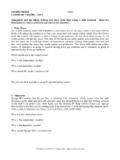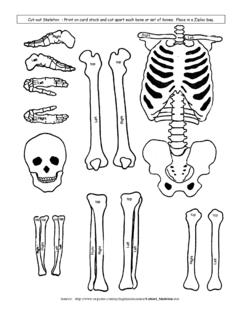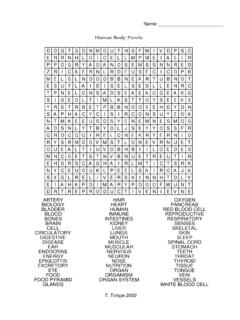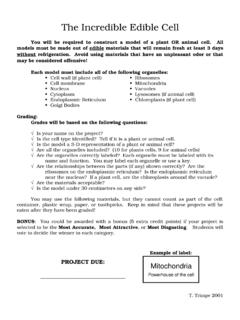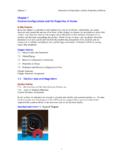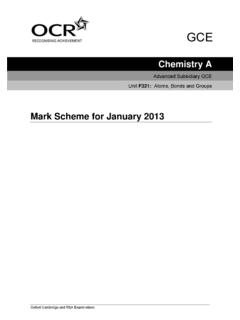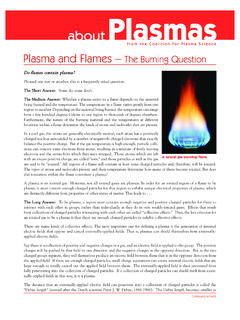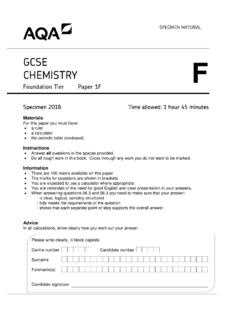Transcription of Chemistry of Matter - Science Spot
1 T. Trimpe 2007 atomic Basics Name _____ Part A: atomic structure 1. Draw five protons in the nucleus of the atom. Label them with their charge. 2. Draw six neutrons in the nucleus of the atom. 3. Draw two electrons in the first energy level and label them with their charge. 4. Draw three electrons in the second energy level and label them with their charge. 5. What element is represented by the diagram? _____ Part B: atomic Calculations 6. Label the information provided in the periodic table. 7. What does the atomic number represent? _____ or _____ 8. What does the atomic mass represent? _____ + _____ 9. How would you figure the number of protons or electrons in an atom? 10. How would you figure the number of neutrons in an atom? 11. Use your knowledge of atomic calculations to complete the chart. Element atomic Number atomic Mass Protons Neutrons Electrons Li P Cl Ni K Ag H Si W Ne 8 O Oxygen T.
2 Trimpe 2007 Part C: Electron Configuration 12. How many electrons can each level hold? 1st = _____ 2nd = _____ 3rd = _____ 13. What term is used for the electrons in the outermost shell or energy level? _____ 14. Scientists use two types of diagrams to show the electron configuration for atoms. Follow your teacher s directions to complete the diagrams. Sulfur atomic # = 16 atomic Mass = 32 Protons = ____ Neutrons = ____ Electron = ____ 15. Calculate the missing information and then draw the Bohr Diagram and Lewis structure for each element. 16. Answer the questions below based on the elements in question #15. (1) Which elements had a filled outermost shell? _____ _____ (2) Which element would be most likely to lose electrons in a chemical bond? _____ (3) Which element would be most likely to gain electrons in a chemical bond? _____ (4) Which elements are not likely to bond with other elements?
3 _____ _____ Why? _____ Bohr Diagram Shows all electrons Lewis structure Shows valence electrons S atomic # = 3 Mass # = 7 # of P = ____ # of N = ____ # of E = ____ Li atomic # = 10 Mass # = 20 # of P = ____ # of N = ____ # of E = ____ Ne atomic # = 12 Mass # = 24 # of P = ____ # of N = ____ # of E = ____ Mg atomic # = 17 Mass # = 35 # of P = ____ # of N = ____ # of E = ____ Cl atomic # = 2 Mass # = 4 # of P = ____ # of N = ____ # of E = ____ He atomic # = 14 Mass # = 28 # of P = ____ # of N = ____ # of E = ____ Si T. Trimpe 2007 atomic Basics Answer Key Part A: atomic structure 1. Draw five protons in the nucleus of the atom. Label them with their charge. 2. Draw six neutrons in the nucleus of the atom. 3. Draw two electrons in the first energy level and label them with their charge. 4. Draw three electrons in the second energy level and label them with their charge. 5. What element is represented by the diagram?
4 BORON Part B: atomic Calculations 6. Label the information provided in the periodic table. 7. What does the atomic number represent? PROTONS or ELECTRONS 8. What does the atomic mass represent? PROTONS + NEUTRONS 9. How would you figure the number of protons or electrons in an atom? USE THE atomic NUMBER 10. How would you figure the number of neutrons in an atom? SUBTRACT THE atomic NUMBER FROM THE atomic MASS 11. Use your knowledge of atomic calculations to complete the chart. Element atomic Number atomic Mass Protons Neutrons Electrons Li 3 4 3 P 15 16 15 Cl 17 1817Ni 592828K 191920Ag 1084747H 101Si 142814W 1717417Ne 102010 NOTE: The number protons and electrons is equal to the atomic number. To find neutrons, subtract the number of protons from the atomic mass. To find the atomic mass, add the number of protons and neutrons. 8 O Oxygen atomic NUMBER SYMBOL NAME atomic MASS T. Trimpe 2007 Part C: Electron Configuration 12.
5 How many electrons can each level hold? 1st = 2 2nd = 8 3rd = 18 13. What term is used for the electrons in the outermost shell or energy level? VALENCE 14. Scientists use two types of diagrams to show the electron configuration for atoms. Follow your teacher s directions to complete the diagrams. Sulfur atomic # = 16 atomic Mass = 32 Protons = 16 Neutrons = 16 Electron = 16 15. Calculate the missing information and then draw the Bohr Diagram and Lewis structure for each element. 16. Answer the questions below based on the elements in question #15. (1) Which elements had a filled outermost shell? He & Ne (2) Which element would be most likely to lose electrons in a chemical bond? Li (Only has 1 valence electron) (3) Which element would be most likely to gain electrons in a chemical bond? Cl (Only needs 1 more electron to fill its outer shell) (4) Which elements are not likely to bond with other elements?
6 He & Ne Why? They have full outer shells. Bohr Diagram Shows all electrons Lewis structure Shows valence electrons S atomic # = 3 Mass # = 7 # of P = 3 # of N = 4 # of E = 3 Li atomic # = 10 Mass # = 20 # of P = 10 # of N = 10 # of E = 10 Ne atomic # = 12 Mass # = 24 # of P = 12 # of N = 12 # of E = 12 Mg atomic # = 17 Mass # = 35 # of P = 17 # of N = 18 # of E = 17 Cl atomic # = 2 Mass # = 4 # of P = 2 # of N = 2 # of E = 2 He atomic # = 14 Mass # = 28 # of P = 14 # of N = 14 # of E = 14 Si

